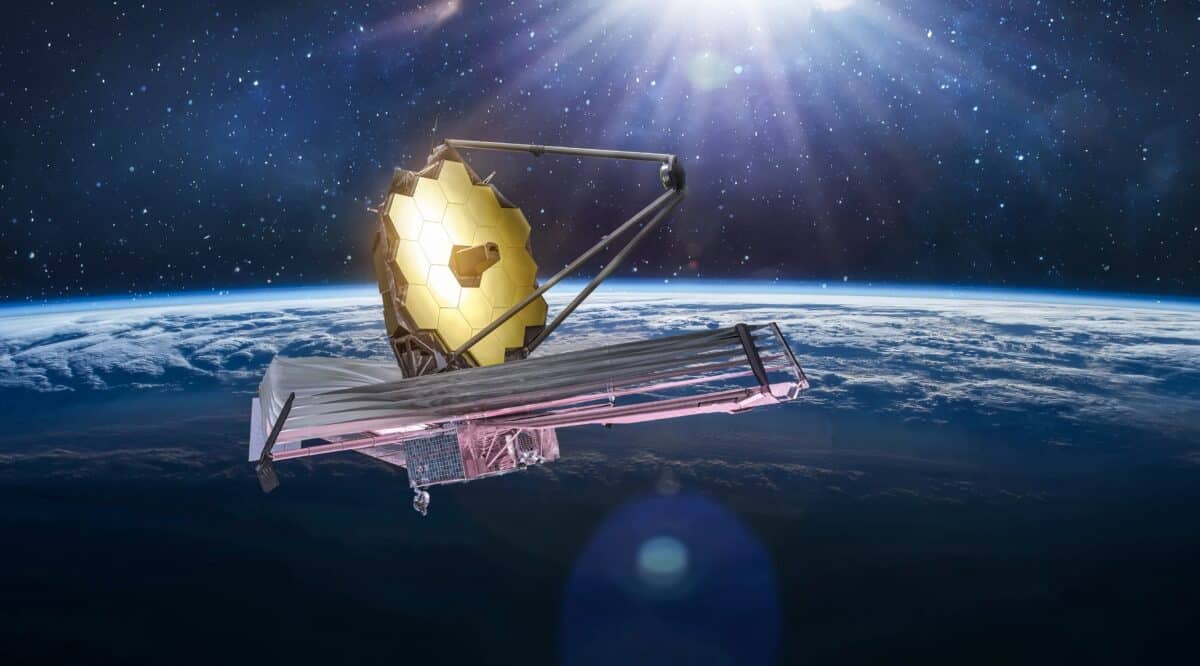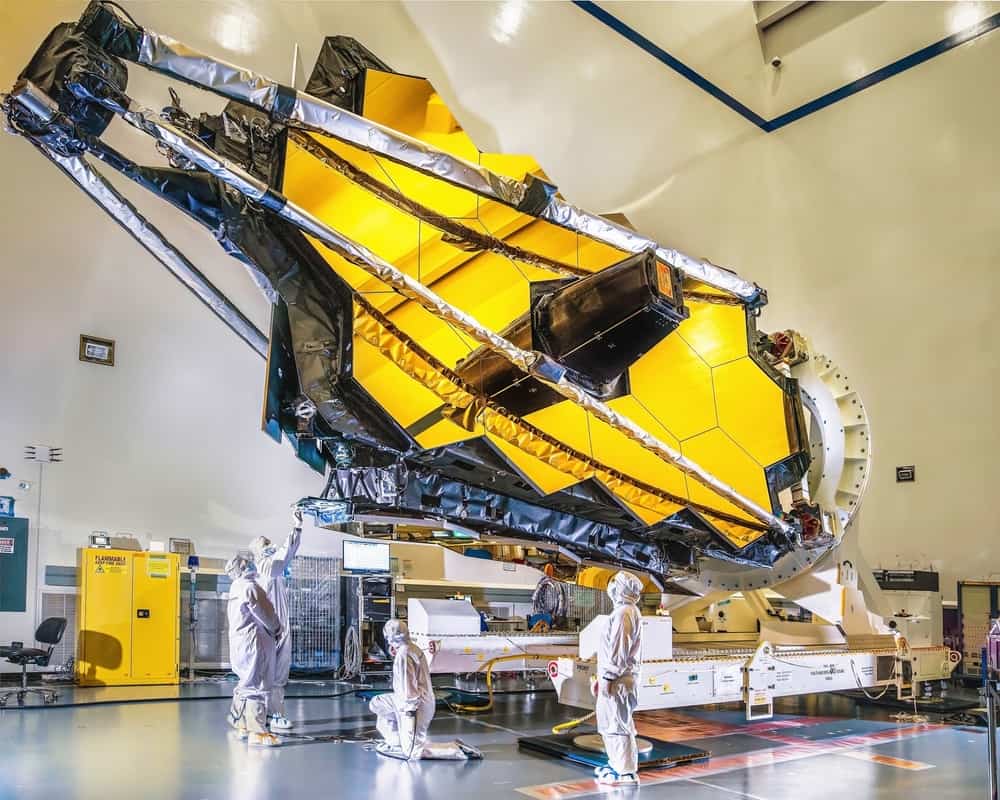In July 2022, President Joe Biden revealed the first images from the James Webb Space Telescope. Like the awe-inspiring photos the Hubble produced, these images announce the historic telescope’s succession into the future.
The newest space telescope is the largest we’ve ever seen and carries incredible new technology. Wondering how this behemoth of a telescope works.
Continue reading about the James Web Space Telescope to learn its history, specs, and more.
History of the James Webb Space Telescope

James Webb Space Telescope use high infrared resolution to capture distant objects in space.
©Dima Zel/Shutterstock.com
The Hubble Space Telescope was pivotal in mapping and understanding the universe. But even before it launched into orbit, the Space Telescope Science Institute (STScI) was already considering the next big instrument.
Proposal and Research
In 1989, the organization revealed its intentions to operate an even larger telescope that could enable infrared wavelength analysis. They opened development to several scientific institutions alongside NASA to figure out the telescope’s feasibility. STScI sought state-of-the-art technology; however, the process took several years.
Many even tried to downgrade the telescope altogether. But NASA was adamant about going forward and urged further development.
In 1997, NASA confirmed the feasibility of a telescope with a primary mirror 8 meters in diameter and started looking for companies to build the telescope’s instruments.
Defense contractors Lockheed Martin, Northrop Grumman, and Ball Aerospace led studies in infrared technology for future scientific study.
Design
In 1998, studies showed an initial design of a working infrared telescope, allowing NASA to issue construction proposals. Four years later, amid proposals, the project received its official name, the James Web Space Telescope (JWST).
Named after the first NASA administrator, the telescope would represent an equally large step forward in discovering our universe.
In 2002, NASA assigned teams to specific projects of the JWST. Northrop Grumman Space Technology, the NASA Science Working Group, and international space organizations in Europe and Canada would make up the foundation of designers.
The Science Working Group would formally approve the guiding requirements for the JWST, and construction began.
Designs of the JWST revealed a total instrument larger than anything ever built; with a concept mirror three times the size of Hubble’s, only a super-heavy rocket could handle the payload.
The ESA’s Ariane 5 rocket, the largest active rocket at the time, was contracted to handle the launch in 2005.
Construction
In 2007,the telescope’s essential technologies were tested successfully under flight conditions. NASA officially moved on to the construction phase and launch tests for the Integrated Science Instrument Module (ISIM).
Launch tests ensured that the module could withstand intense launch conditions and extreme heat and cold in space.
Construction of essential components took several years, but in 2012, they were completed and sent to Goddard Space Flight Center in Maryland for assembly and testing. These included the four testing instruments and the backplane, heat shield, and primary mirror.
Testing and Launch
For another six years, respective teams workers to ensure all devices communicated with each other as intended. Testing was critical due to the telescope’s required position in space; Beyond Earth’s lower orbit, the JWST would not receive repairs after launch like the Hubble.
Every instrument had to test for extreme temperatures, as the instruments needed to be cold to work properly.
All maintenance and testing on the telescope were completed in 2018, and the instrument was ready for launch. NASA sent observation proposals out and the telescope.
The Ariane 5 rocket with the JWST payload launched from French Guiana on December 25, 2021. The telescope cruised for another month to its final destination with its mirrors deployed and active.
Cost
The JWST was expected to cost $5 billion and launch in 2014. However, due to poor coordination, the project lagged for seven years, and the price of the telescope nearly doubled. The construction of the James Webb cost NASA $8.8 billion, nearly a third of their astrophysics budget for over two decades.
Scientists explain the implications of a project this large. The James Webb Space Telescope is one of the most expensive devices ever built, and its delay impacted the development of other projects.
That said, JWST is worth the additional cost and time, as no other telescope matches its range and capability.
How Does the James Webb Space Telescope Work?

©BEST-BACKGROUNDS/Shutterstock.com
The most prominent feature of the James Webb Space Telescope is its ensemble of 18 gold-plated, hexagonal mirrors. Because the primary mirror of the JWST was nearly three times the size of Hubble’s, the instrument could not build it as a single piece.
To safely launch the telescope, the primary mirror was designed to fold in for launch. The mirrors would then unfold and adjust into shape as the telescope reached its destination.
The JWST was equipped with infrared technology to achieve its missions (more on these below). This allows it to see through space dust and gas that conceal essential areas of study. However, these infrared instruments must stay below a certain temperature.
With the telescope facing the same direction for long periods, scientists needed to shield the tools from incredible heat. To solve this issue, they developed a five-layer heat shield that reduced the force of the Sun by a million times.
While the Sun-facing side reaches temperatures of over 200 degrees Fahrenheit, the other side can be as cold as minus 400 degrees Fahrenheit.
The James Webb Telescope takes advantage of its position in the second lagrange point (L2), where it can orbit the Sun alongside the Earth and stay in a fixed direction to observe incredibly faint signals.
With its incredible heat shield, the JWST uses four instruments to collect and analyze infrared wavelengths. These include:
- Near Infrared Imager and Slitless Spectrograph (NIRISS)
- Near Infrared Spectrograph (NIRSpec)
- Near Infrared Camera (NIRCam)
- Mid Infrared Instrument (MIRI)
Let’s take a look at each one in more detail.
Near Infrared Imager and Slitless Spectrograph (NIRISS)
This instrument analyzes infrared wavelengths ranging from .8 to 5 microns (one-millionth of a meter). The slitless spectrograph will detect the first lights of new stars and exoplanets and their traveling direction.
The NIRISS is also equipped with the Fine Guidance Sensor (FGS), which helps keep the entire Webb telescope pointing in a precise direction.
Near Infrared Spectrograph (NIRSpec)
The NIRSpec works in the same wavelength as the first instrument and uses a series of microscopic shutters to collect a spectrum of dispersed light from many areas at once. This innovative technology allows the NIRSpec to study up to 100 objects simultaneously.
Because James Webb has to stare at an object for a long time (it’s trying to look up to 13.6 billion lightyears away), this significantly improves the number of objects it can study in its lifetime.
Near Infrared Camera (NIRCam)
The NIRCam is the primary imager on the JWST that detects near-infrared wavelengths of .6 to 5 microns. The imager is equipped with coronagraphs, devices that allow astronomers to visualize the objects that the NIRCam captures. Using these visualizations, NASA artists render beautiful images that inspire us to explore the universe.
Mid Infrared Instrument (MIRI)
The MIRI is the James Webb Space Telescope’s only mid-infrared tool and combines a few smaller tools into its functions. It uses a spectrograph to disperse light from an object into a spectrum. With its wide-field camera, MIRI can capture images of newly forming stars and other phenomena in the mid-infrared wavelength range.
The James Webb Space Telescope Missions
The JWST uses infrared instruments to see farther than any telescope before it. However, the nature of these wavelengths requires the telescope to operate well beyond the disruptive atmosphere of the Earth.
NASA opted to position the Webb one million miles from the planet. Unfortunately, the distance puts the telescope out of maintenance range. For a tool as critical as this, NASA scientists had to define its before its construction.
In 2005, NASA’s Science Working Group for the JWST established four driving goals:
- Observe the early universe
- Study galaxy development over time
- Witness the lifecycle of new stars
- Examine exoplanets
Observe the early universe

©comete geo/Shutterstock.com
The JWST uses massive telescopic mirrors to see galaxies 13.6 billion lightyears away. Because light travels at a finite speed, the images we see represent what those galaxies looked like in the past. This gives us insights into the earliest formations of our universe.
Because the universe is expanding, these light wavelengths stretch, entering the infrared range. The JWST is specifically designed to analyze these kinds of waves.
Study galaxy development over time
The Webb will use its range and infrared technology to study the forms of newer galaxies than the older ones that Hubble has studied. There are expectations that these rapidly-developing galaxies are asymmetrical, dense, and feature a supermassive black hole.
Witness the lifecycle of new stars
When the universe births new stars, they develop in a cocoon of space dust (the remnants of old stars). All that debris is difficult to view in ultraviolet but not a problem in infrared. This makes Webb the ideal space telescope to witness the early stages of star formation.
Examine exoplanets
With interest in space exploration surging with Elon Musk’s goal to colonize Mars, the astronomy community is discovering new planets in nearby galaxies. Scientists are particularly excited to find Earth-like planets that could potentially sustain life.
While space dust makes it difficult for planetary telescopes to view them, The JWST will be able to see the composition of these planets, providing insights into how life-sustaining solar systems develop around stars.
The James Webb Space Telescope Specs
| Proposal date | September 13, 1989 |
| Launch date | December 25, 2021 |
| Also known as | Next Generation Space Telescope, JWST, Webb |
| Size | 66 ft long, 46 ft wide |
| Weight | 13,584 lbs |
| Cost | $8.8 million |
| Associated organizations | Space Telescope Science Institute (STScI), NASA, European Space Association (ESA), Canadian Space Association (CSA), Northrop Grumman, Ball Aerospace |
| Location | Lagrange Point 2 (L2) |
| Distance from Earth | 1 million miles |
| Primary mirror diameter | 21 ft 4 in (18 hexagonal segments) |
| Innovative technology | Folding primary mirror, 5-layer heat shield, infrared imaging, and spectrometry |
| Missions | Study the early universe, the development of galaxies, the birth of new stars, and exoplanets |
Space and Exploration: Further Reading
Just as the Hubble brought us beloved and spectacular images of the universe, the James Web Space Telescope will expand our knowledge of the universe.
This phenomenal device marks a huge leap forward in space technology in our age. For more on how we’re reaching for the cosmos, check out these articles below.
- The 10 Most Powerful Rockets Ever Built – Here are the biggest workhorses in spaceflight history.
- The 10 Largest Space and Exploration Companies in the World – From rocketry to communication to research, these companies lead spaceflight development.
- SpaceX’s Starship Rocket: Specs, Size, History, and More – A deep dive into the largest rocket the world has ever seen.
- Computers in Space: How Microchips and Code Unlocked the Stars – Check out how the inner workings of spacecraft allow us to explore the universe.